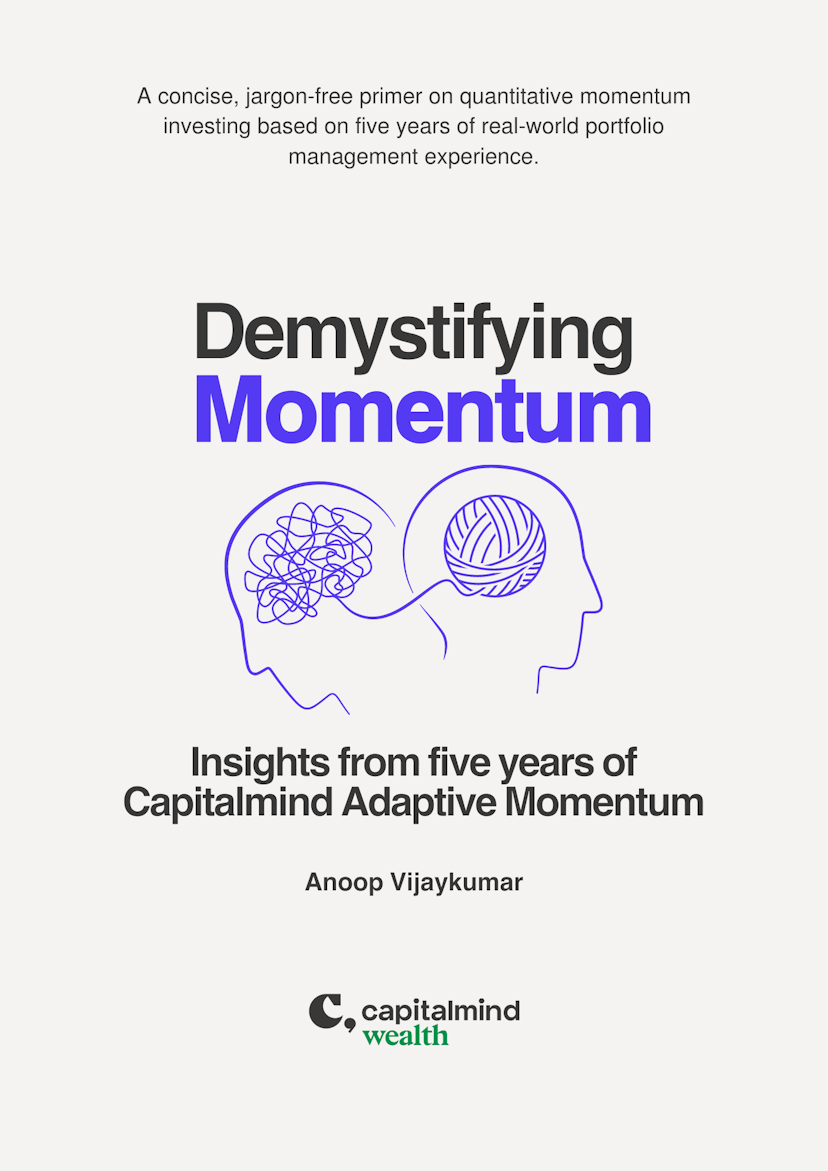Adaptive Momentum
Powered by our rigorous quantitative model, Capitalmind Adaptive Momentum analyzes the universe of investable securities to pinpoint those exhibiting strong price momentum. The portfolio seeks to capitalise on the continuation of existing trends. Since going live in 2019, Capitalmind Adaptive Momentum has one of the longest real money track records of its kind in India.
Strategy Overview
A systematic portfolio approach built on the core principle of the momentum factor, that stocks that have exhibited strong price momentum continue to do so for some time.
Key Features

Quantitative Portfolio Selection
Our algorithm scores and ranks the universe of investable stocks on a composite metric quantifying price momentum and allocates to the stocks in the top-decile, repeating this process at regular intervals.

Waters the flowers, Pulls the weeds
Objective set of rules that continue holding stocks that show continued price momentum while exiting those that fade. Ensures only the strongest stocks stay in the portfolio with a consistent rebalance frequency.

Fluid across Market Caps and Sectors
Sector and market-cap agnostic strategy that allocates to the pockets showing strongest relative price momentum with robust risk-management built in that goes fully or partially to cash when market conditions dictate.

Risk Management - A key part of its design
Quantitative filters that shift the portfolio partially or fully out of equities into alternate assets or cash when market weaken, for effective risk-management.
Globally Researched, by academics and practitioners
Demystifying Momentum
Capitalmind Adaptive Momentum is India's longest-running Momentum PMS strategy. One Rupee invested in Adaptive Momentum at inception would be worth 3.53 in five years, an increase of 253%. The same rupee invested in the NSE500 would be worth 2.35, a 135% increase. This paper is for the non-finance investor to understand, jargon-free, from our experience managing a quantitative momentum strategy with real capital, giving you real insights to help you determine how it might fit into your wealth-creation journey.
Download the paper
Behavioral Drivers of Momentum Investing
- Short-term under reaction: Investors notice big dramatic shifts but ignore minor but frequent changes in the near term.
- Anchoring: Investors change long-held perceptions slowly about which companies are good or bad
- Disposition Effect: Investors often sell winners, but keep losers, driving a more gradual price rise.
- Cognitive Dissonance: Contradictory news affects investor sentiment, delaying its impact on stock prices. Losers remain undervalued while winners maintain momentum.
How our approach differs from conventional Momentum Investing
Adaptive Momentum is a scalable investing strategy meant to deliver superior risk-adjusted returns over the long term.

Robust Momentum Methodology
Conventional momentum investing uses discrete point-to-point returns to score and rank stocks. Adaptive Momentum utilises a composite return metric adjusted for volatility.

Entry filters
Adaptive Momentum incorporates short-term price and volume criteria that improve downside volatility by reducing probability of sharp reversals soon after entry

Portfolio-level Risk Management
Rules to shift partially or fully to cash in broad market declines to reduce downside volatility. Capped exposure to sectors and business groups to reduce concentration risk.

Iterative Review & Improvement Process
Adaptive Momentum continues to evolve to improve its risk-reward characteristics through a rigorous quantitative backetsting process that simulates real-world implementation challenges
Capitalmind Adaptive Momentum Performance
Inception Date: 2019-03-05
Returns are net of fees and transaction costs. Returns for periods >1Y are annualized.
Performance data is not verified by SEBI.
Last updated: 2025-12-19
Downloads
Find the detailed presentation for more on the Capitalmind Adaptive Momentum Strategy
Frequently Asked Questions
What is the universe of stocks in which Adaptive Momentum invests?
The universe is all investable stocks listed on the NSE. Only stocks meeting the liquidity criteria in terms of average traded values are considered. Typically, this means allocating to the top 500 stocks by market cap with a few exceptions outside of those.
How do you ensure your backtest results are realistic?
Poorly constructed backtests lead to inaccurate or just plain wrong conclusions. Our in-house backtesting framework mitigates the biggest issues that afflict backtests. Two examples for illustration, the base data is survivorship-bias-free and validated through multiple checks. Incorporating point-in-time liquidity data constraints ensures only positions possible in a real-world portfolio.
What are the reasons NOT to invest in Adaptive Momentum?
There are five reasons: 1. Momentum by design is a higher-churn strategy than the typical buy-and-hold approach 2. Need to get used to being wrong. Backtests show nearly half of the positions entered exit in the red. The returns come from losing less and winning more 3. Can hold 'ugly' stocks i.e. stocks that have no on-going story, because it picks stocks quantitatively 4. It has and will get written off from time to time, especially by investors who invest in it without understanding the underlying principle 5. Most importantly, we know from backtests that it trails the index especially on a 1-year basis roughly a third of the time. Only over longer holding periods, the chances of outperforming the index go up significantly.
When is a good time to invest in Adaptive Momentum?
Historically, returns from equities as an asset class are lumpy, a cycle of exceptionally good years followed by not-so-great time periods and back. This means its impossible to predict when they arrive. This applies to Adaptive Momentum as well. So, being invested with a minimum three to five year timeline is the most effective way to harvest the returns when the market offers them.
What is an appropriate allocation of overall equity exposure to Adaptive Momentum?
Think of Adaptive Momentum as a flexicap long-only equity portfolio that buys showing a specific set of characteristics. Our client advisors make recommendations based on specific risk-profiling. In a nutshell, for investors with a 10+ year investing horizon, the ideal allocation (to any strategy) is directly related to how well you've understood the philosophy and can see yourself holding it when the inevitable periods of underperformance occur.
What is the fee structure for Adaptive Momentum?
Capitalmind PMS charges a fixed 1% of AUM as fee for Adaptive Momentum. We do not charge a percentage of returns made. In addition, there is zero entry or exit load. Download Fee calculator here
Demystifying Momentum Investing
In this video, we talk about the real-world lessons learnt from five+ years of managing the Adaptive Momentum portfolio

Podcast #33: Momentum Investing, Unintuitive yet Effective
In this episode, Shray and Anoop discuss momentum investing and how we implement it as portfolios at Capitalmind.
Connect with our Client Advisory Team
Get your customised strategy consultation on how Adaptive Momentum can fit into your long-term investment plan.
SEBI Regd. Portfolio Manager : INP000005847